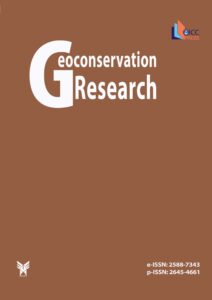Geological Heritage Site for the Rajmahal Flora at Mandro, Sahibganj, India: An Opportunity for an Integrated–Sustainable Tourism Circuit
Authors
Abstract
Mandro in Sahibganj District of Jharkhand State, India is known for its abundance of petrified wood and floral impressions from the Rajmahal Traps of Albian–Aptian age. This locality is among the 34 Geological Heritage Sites identified by the Geological Survey of India. The scientific importance of the site is vested in the intricate preservation of petrified wood and floral impressions in a single locality. The plants were transported by pyroclastic volcanic activity, and the tuff and crystal-laden pumice helped preserve the fossils, including upright tree stumps with intact root systems. Such an association of floral fossils with ignimbrite is of high scientific relevance and is one of its kind in India. At present, the Geoheritage Site, Mandro is compromised by the lack of legislative provisions guiding conservation of the site. Our study highlights bottlenecks in the development of the Geoheritage Site and suggests the formulation of an integrated–sustainable tourism circuit combining natural, anthropological, cultural and historical touristic components. We advocate operating the circuit through community participation, ensuring trust and capacity building among the local People. The circuit is an exclusively local tourism engine that could address socioeconomic disparities while developing as a hub for research and innovation across different disciplines. Paramount to these efforts is attaining Sustainable Development Goals and global recognition for the Geoheritage Site and the Circuit.
Read the full text of the articleKeywords
References
Branney MJ and Kokelaar P (2002). Pyroclastic density currents and the sedimentation of ignimbrites. Geological Society, London, Memoirs, 27.
Carcavilla L, Duran JJ, Garcia-Cortes A and Lopez-Martinez J (2009). Geological heritage and geoconservation in Spain: past, present, and future. Geoheritage. 1: 75–91.
Cas RAF and Wright JV (1996). Volcanic successions: Modern and ancient. Chapman & Hall.
Census of India (2011). Jharkhand Series-21 Part XII – B. District Census Handbook. Sahibganj village and town wise primary census abstract. https://sahibganj.nic.in/document-category/census/ (Accessed on 19.12.2022)
Geological Survey of India (2023). Geotourism / Geoheritage Map of India https://bhukosh.gsi.gov.in/Geotourism.
Golani PR., Bandopadhyay KP, D’Souza, MJ, Bagchi J, Bhattacharjee S, Ghatak S, Sesha Sai VV, Ghatak M, Gupta S, Bishwapriya A, Dora ML and Rout D (2016). Geotourism hotspots of Indian Subcontinent, Special publication by 36th IGC Secretariat, New Delhi.
Gray M (2018). Geodiversity: The backbone of Geoheritage and Geoconservation. In: Geoheritage Assessment, Protection and Management. Elsevier, Amsterdam, pp. 13–25.
International Union of Geological Sciences (2022). The first IUGS geological heritage sites. IUGS 60th Anniversary.
Kent RW, Pringle MS, Muller RD, Saunders AD, and Ghose NC (2002). 40Ar/39Ar Geochronology of the Rajmahal Basalts, India, and their relationship to the Kerguelen Plateau. Journal of Petrology. 43: 1141–1153.
Mc Clelland J (1850). Report of the Geological Survey of India for field season 1848-49. Military Orphan Press.
Mukhopadhyay G, Mukhopadhyay SK, Roychowdhury M and Parui PK (2010). Stratigraphic correlation between different Gondwana Basins of India. Journal Geological Society of India. 76: 251–266.
National Council for Educational Research and Training, Govt. of India – NCERT (2022-23). Textbook in History for Class XII. Themes in Indian History: Part III. Theme 10. 266–275.
Newsome D & Dowling R (2018). Geoheritage and geotourism. Geoheritage. Elsevier, Amsterdam, pp. 305–321.
Oldham T (1854). A brief summary of the results of an examination of the Rajmahal Hills made during cold seasons of 1852-53. Journal of Asiatic Society of Bengal, Vol – 23.
Raja Rao CS (1987). Coalfields of India. Bulletin of Geological Survey of India. Series A, No. 45: 336.
Sastry MVA, Achryya SK, Shah SC, Satsangi PP, Ghosh SC, Singh G (1977). Classification of Indian Gondwana sequence – A reappraisal. Fourth International Gondwana Symposium, India. Papers Volume – II. Geological Survey of India.
Sengupta S (1988). Upper Gondwana stratigraphy and palaeobotany of Rajmahal Hills, Bihar, India. Geological Survey of India. Palaeontologia Indica. 48: 1–182.
Sigurdsson H, Houghton BF, Mcnutt SR, Rymer H and Stix. (2000). Encyclopedia of Volcanoes. Academic Press.




